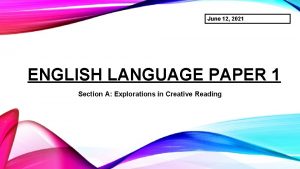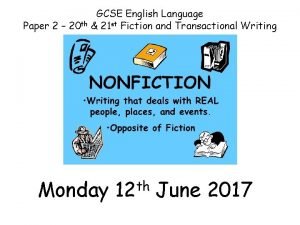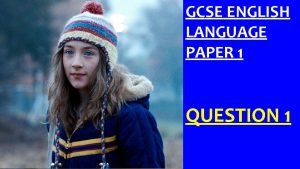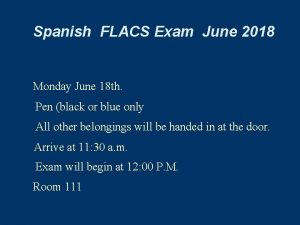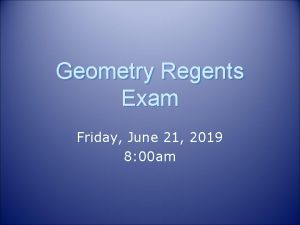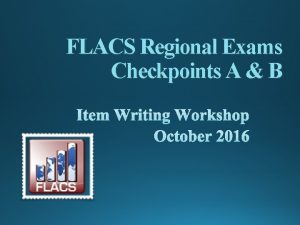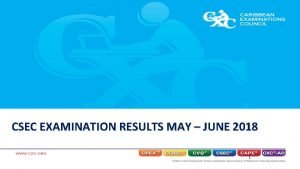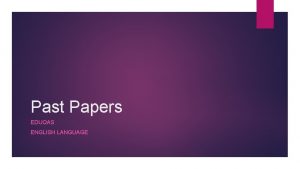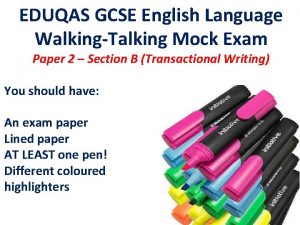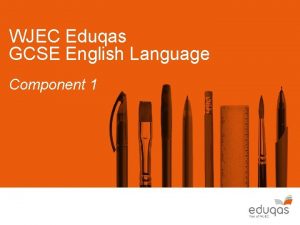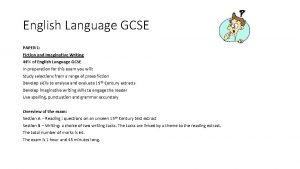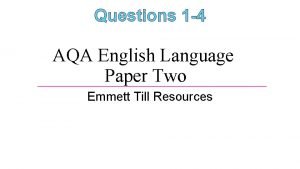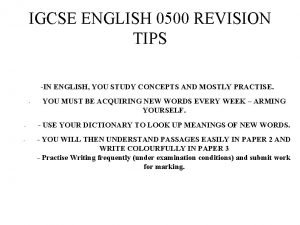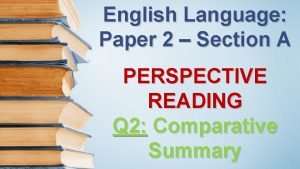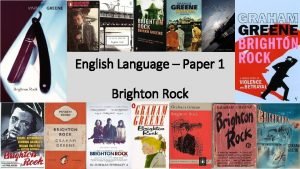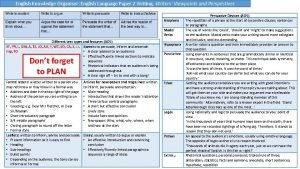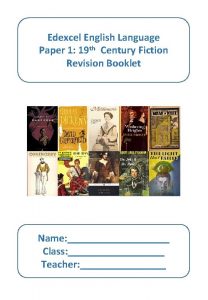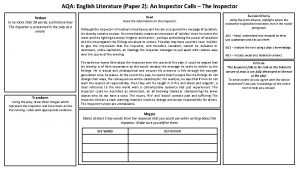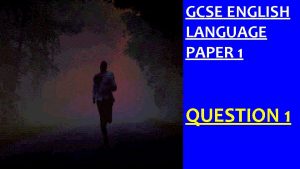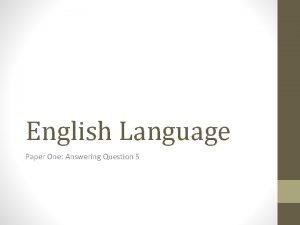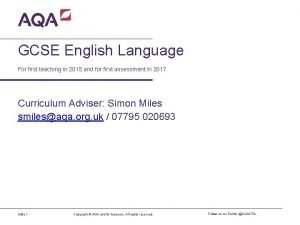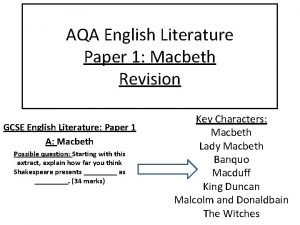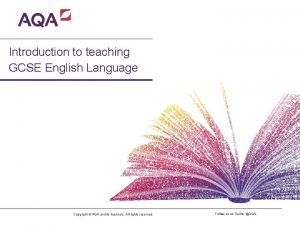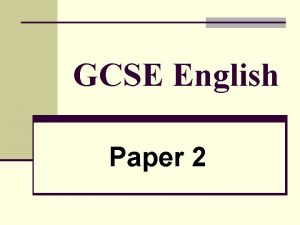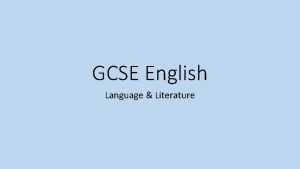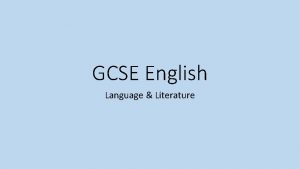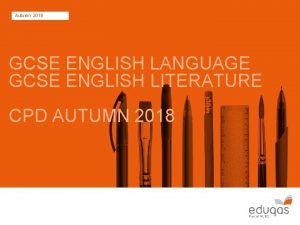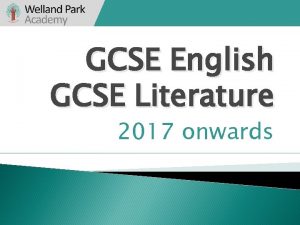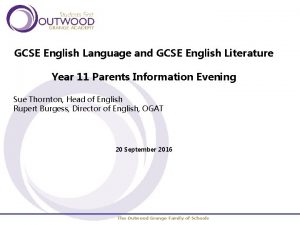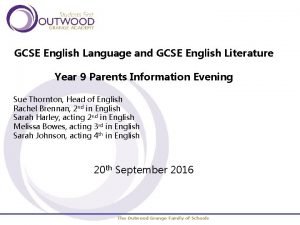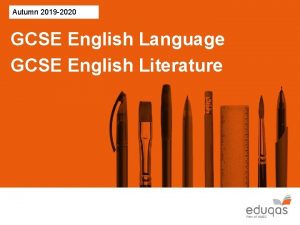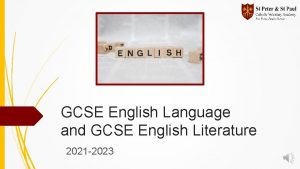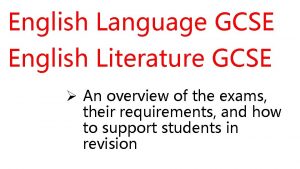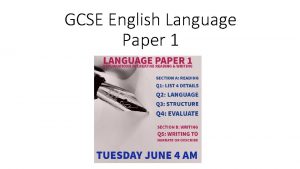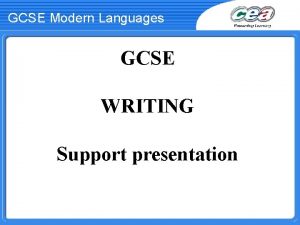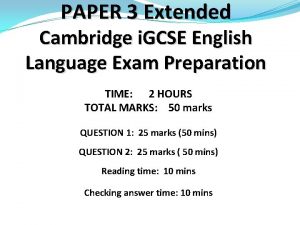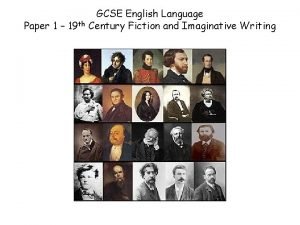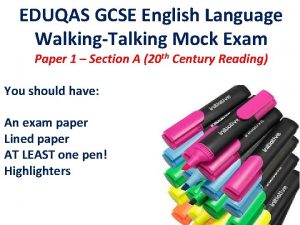GCSE English Language Paper 1 June 2018 Paper































- Slides: 31

GCSE English Language (Paper 1) June 2018 Paper 1: Section A Q 1. List four things. . . (4) Q 2. How has the writer used language. . . (8) Q 3. How has the writer structured. . . (8) Q 4. To what extent do you agree with the statement that. . . (20)

Question 1: • A bit like a ‘warm up’ task. • Highlighting key points from the content. . • An ‘easy win’ for 4 marks. Q 1) List four things you learn about. . .

TASK: Write a timed response 5 minutes. English Language Paper 1: Jigs and Reels by Joanne Harris Q 1: UNDERSTANDING 1. Read again lines 1 -4 of the source. List four things about Mr Fisher from this part of the source. (4 marks) • He lived alone 5 minutes • He lived in a terraced house • He lived in a small house • He lived in the centre of town • He did most of his weekend marking in school • He travelled home by bus / he didn’t own a car. • He took some books and papers home to mark AO 1 • Identify and interpret explicit and implicit information and ideas.

Q 2: LANGUAGE 2. Look in detail at the extract from lines 5 -11 of the source. How does the writer use language here to convey Mr Fisher’s views on books and stories of the past? You could include the writer’s choice of: - words and phrases; - language features and techniques; - sentence forms. Anything interesting about the way the sentence is put together. E. G… Verbs Adjectives Nouns (8 marks) E. G… Simile Repetition Personification AO 2 • Explain, comment on and analyse how writers use language and structure to achieve effects and influence readers, using relevant subject terminology to support their views. 12 minutes

Question 2 Preparation – Highlight any key words or Use of listing similes to suggest stories were fastphrases where language is used to describe paced, they ambushed the imagination so that readers were immersed and transported through words. Mr Fisher’s views on books & stories. Mr Fisher remembered a time –surely, not so long ago – when books were golden, when imaginations soared, when the world was filled with stories which ran like gazelles and pounced like tigers and exploded like rockets, illuminating minds and hearts. He had seen it happen; had seen whole classes swept away in the fever. In those days, there were heroes; there were dragons and dinosaurs; there were space Use of adjective adventurers and soldiers of fortune and giant apes. In those ‘golden’ & verb ‘illuminating’days, suggeststhought Mr Fisher, we dreamed in colour, though films Mr F has a were in black and white, and good always triumphed in the end. romanticised and nostalgic view of books of the past being precious and sparking originality. Use of subordinate clauses at the start of sentences places emphasis on Mr F viewing the past as being a time when books unleashed students’ imaginations, implying that present day students are now stifled by a loss of creativity.

Q 2: EXAMINERS ARE LOOKING FOR… Level 4 Perceptive, detailed Skills Descriptors Detailed and perceptive understanding of language Analyses the effects of the writer’s choices of language Judicious range of quotations Uses sophisticated subject terminology accurately 7 -8 marks Clear understanding of language Level 3 Clearly explains the effects of the writer’s choices of Clear, relevant language Range of relevant quotations 5 -6 marks Use subject terminology accurately Some understanding of language Level 2 Attempts to comment on effect of language Some, attempts Selects some relevant quotations 3 -4 marks Some subject terminology, not always appropriately Level 1 Simple, limited 1 -2 marks Simple awareness of language Simple comment on the effect of language Simple references to textual details Simple mention of subject terminology

Q 2 Example answer: Student 1 How has the writer used language to convey Mr Fisher’s views on books and stories of the past? (8 marks) The writer uses the adjective “golden” to suggest Mr Fisher has a positive, glowing view of the books in the past. He then uses similes “ran like gazelles and pounced like tigers”. This shows that the stories were like animals, fast paced and attacking the readers’ imagination so that they are gripped when they are reading. The writer then uses the sentence illuminating minds and hearts” to suggest Mr Fisher thinks that in the past, these stories lit up every part of the reader with enthusiasm. L 3 - Shows clear understanding of language: marks q q q 5 -6 Explains clearly the effects of the writer’s choices of language Selects a range of relevant textual detail Makes clear and accurate use of subject terminology

Q 2 Example answer: student 2 How has the writer use language to convey Mr Fisher’s views on books and stories of the past? (8 marks) The writer uses the adjective “golden” to suggest Mr Fisher has a nostalgic view of books being very precious Level 4 - Shows detailed and this is reinforced by the verb “illuminating” to give a romanticised perceptive understanding of view of how they light up readers’ language: 7 -8 marks imaginations. Readers sense that Mr Fisher q Analyses the effects of the prefers novels of the past because he writer’s choices of language begins two sentences with the subordinate q Selects a judicious range of clause “In those days”. This presents his view of past novels and stories unleashing textual detail students’ imaginations, implying that q Makes sophisticated and today’s students are hindered and stifled accurate use of subject by a loss of creativity. terminology He then lists several similes to describe the impact of stories of the past, that “ran like gazelles and pounced like tigers”. This suggests that stories were fast -paced, ambushing the imagination so that

Q 2: Possible answers Detailed responses: - Respond to the wording of the question - Integrate quotations that are connected - Analysis of writer’s methods - Refers to impact on readers. LEVEL 4: DETAILED LEVEL 3: CLEAR LEVEL 2: SOME LEVEL 1: SIMPLE ? ? TASK: Now upgrade your response in purple pen.

Q 3: EXAMINERS ARE LOOKING FOR… Level Skills Descriptors Analyses the effects of a range of structural features confidently Level 4 and in detail. Perceptive, detailed Sophisticated use of technical terminology used accurately. Perceptive range of examples from across the text. 7 -8 marks Clearly explained effects of a variety of structural features. Level 3 Technical terminology is used accurately throughout. Clear, relevant Suitable examples from the whole text are used & explored. 5 -6 marks Level 2 Some, attempts 3 -4 marks Level 1 Simple, limited 1 -2 marks Some structural features are explained. Some technical terminology is used. May not always be accurate. Some points are supported with relevant examples. Basic attempts to comment on a few structural features in a simple manner. Simple or no mention of subject terminology. Few references are made and are not always relevant.

What do we mean by structure? q This happens q Then this happens This isn’t helpful! It leads to a re-telling of the story q Then this happens There is no sense of a writer at work q Finally this happens There is no comment on the effect on a reader

What do we mean by structure? q This happens. The writer has done this because… The effect is … q Then this happens. The writer has done this because … The effect is… q Then this happens. The writer has done this because …. The effect it… q Finally this happens. The writer has done this because …. The effect it… Still quite basic BUT q There is now an understanding that the story has been PUT TOGETHER by the writer with a CONSCIOUS attempt to influence the way we think about the story However q Not a range of METHODS q No understanding of the structure of the text as a whole

Structure: What do we need to look for then? Look for 3 key moments in the text… q The beginning Then, consider… q Does the opening prepare us for the ending? q Identify a change in q Does the rest of the focus/mood/pace / tense text build up to the ending? q The ending / Links to the q Is there a pivotal beginning moment in the text?

English Language Paper 1: Jigs an Reels by Joanne Harris Q 3: STRUCTURE You now need to think about the whole of the source. This text is from the beginning of a short story. How has the writer structured the text to interest you as a reader? You could write about: 12 minutes • what the writer focuses your attention on at the beginning • how and why the writer changes this focus as the source develops • any other structural features that interest you. (8 marks) E. G. - Ordering events/sequence through a passage - Beginnings / middle / endings. -Changes in ideas and perspectives & how they are signaled to readers. -Links between the ending / opening. AO 2 • Explain, comment on and analyse how writers use language and structure to achieve effects and influence readers, using relevant subject terminology to support their views.

TASK: Write a timed response 12 minutes. Q 3: STRUCTURE You now need to think about the whole of the source. This text is from the opening of a novel. How has the writer structured the text to interest you as a reader? You could write the about: Task 1: in pairs, break text into 3 parts: • what the writer focuses your attention on at the beginning • how and why the writer changes this focus as the BEGINNING source develops CHANGE • any other structural features that interest you. (8 marks) ENDING Task 2: make notes on what happens at each stage, how it changes and its effect. AO 2 • Explain, comment on and analyse how writers use language and structure to achieve effects and influence readers, using relevant subject terminology to support their views.

Q 3: Possible answer 8/8 How has the writer structured the text to interest you as the reader? (8 marks) The text begins with a domestic setting of Mr Fisher’s home “in a small terraced house in the centre of town”. His school room setting is also described to give readers insight into his home and work before introducing his difficulties in engaging his students with creative writing. There is then a change in time, from present to past tense, initiated by “Mr Fisher remembered a time” to transport readers to the past when students were not disenchanted by reading. He continually changes from past to present, as the middle paragraph begins with “Now everything was in black and white” to highlight his nostalgia for the colourful past. Though there is a passage in time, the tone of disillusionment remains until the connective word “But” is used towards the end to signal a pivotal moment where Mr Fisher finds “a nugget of gold” in his marking. The writing becomes more dramatic, more punctuated and fast paced to show Mr Fisher’s excitement. This is a contrast to the slow pace of the opening where he generalised his marking as “two or three stacks of books”, instead he now humanises it as “Tibbet’s story” to prove his reasons to be disenchanted with students, wrong as his own imagination had become illuminated by a student’s piece of writing.

TASK: Now upgrade your response in purple pen. Q 3: How does the writer use structure to interest you as a reader? • STRUCTURAL methods • Evidence from the text • Effects / Impact on reader Though there is a passage in time, the tone of disillusionment remains until the connective word “But” is used towards the end to signal a pivotal moment where Mr Fisher finds “a nugget of gold” in his marking. The writing becomes more dramatic, more punctuated and fast paced to show Mr Fisher’s excitement. This is a contrast to the slow pace of the opening where he generalised his marking as “two or three stacks of books”, instead he now humanises it as “Tibbet’s story” to prove his reasons to be disenchanted with students, wrong as his own imagination had become illuminated by a student’s piece of writing.

Q 3: EXAMINERS ARE LOOKING FOR… Level 4 Perceptive, detailed Skills Descriptors Analyses the effects of a range of structural features confidently and in detail. Sophisticated use of technical terminology used accurately. Perceptive range of examples from across the text. 7 -8 marks Level 3 Clear, relevant 5 -6 marks Clearly explained effects of a variety of structural features. Technical terminology is used accurately throughout. Suitable examples from the whole text are used & explored. Level 2 Some, attempts 3 -4 marks Some structural features are explained. Some technical terminology is used. May not always be accurate. Some points are supported with relevant examples. Level 1 Simple, limited 1 -2 marks Basic attempts to comment on a few structural features in a simple manner. Simple or no mention of subject terminology. Few references are made and are not always relevant.

Understanding question 4. Focus this part of your answer on the second part of the source, from line 25 to the end. A reader said: “This part of the story, where Mr Fisher is marking homework, shows Tibbet’s story is better than Mr Fisher expected, and his reaction is extreme. ” 20 minutes To what extent do you agree? - Q 4 asks your opinion of the writer’s skill – assume that the text has been chosen because it is a GOOD, SKILLFUL piece of writing. - See this question as an ‘appreciation’ of the writing where you explain how the writer achieved effects. (Don’t be negative). - The question “To what extent do you agree? ” is an invitation to say WHY you agree, although you can have some reservations.

Exam Preparation TASK: Write a timed response 20 minutes. 25 September 2021 Paper 1, Question 4 – Evaluating how effective a text is. AO 4: Critically evaluate and give a personal response to a text. Focus this part of your answer on the second part of the source, from line 25 to the end. A reader said: “This part of the story, where Mr Fisher is marking homework, shows Tibbet’s story is better than Mr Fisher expected, and his reaction is extreme. ” Find 3 quotes and methods To what extent do you agree? In your response, you could: § (1 -2 on each) to support this. Consider your own impression of what Mr Fisher expected Tibbet’s homework to be like § Evaluate how the writer conveys Mr Fisher’s reaction to what he discovers § Support your response with reference to the text

Exam Preparation Level 2 10/20 25 September 2021 Paper 1, Question 4 – Evaluating how effective a text is. Student A I mostly agree with the student’s statement because Mr Fisher is not expecting Tibbet’s story to be so good. He says “he was not a brilliant scholar” and “he took a deep breath” and this shows that he does not think it will be that good. The word “breath” is like he is preparing himself for a boring piece of work. Also, Mr Fisher’s reaction is extreme because the writer states that he began to sweat and “his breathing quickened” and this makes readers wonder whether it will be something interesting. At the end of the extract, Mr Fisher cannot believe how good Tibbet’s work is and there is quite a rushed description of everything that was brilliant about it, to support the student’s statement that this was unexpected. AO 4: Critically evaluate and give a personal response to a text. States an opinion Needs to be developed to explain the writer’s METHODS used to describe Mr Fisher’s reaction Begins to address how the text makes the reader feel Needs a quote from the text to back-up this good point

Exam Preparation 25 September 2021 Paper 1, Question 4 – Evaluating how effective a text is. Level 4 20/20 TASK: Now upgrade your response in purple pen. I mostly agree with the student’s statement that Tibbet’s story is better than Mr Fisher expected. This is due to the fact that Mr Fisher had universalized his students as lacking in imagination so his expectation of Tibbet was low. Though he had “a spark in him which deserved attention”, Tibbet was judged as having “obviously done part of his homework on the bus. ” The use of the noun “spark” suggests there was only a glimmer of hope for the boy’s writing though, when juxtaposed with where he did his homework, this hope diminishes just as Mr Fisher’s had – and, too, supports the student’s view. AO 4: Critically evaluate and give a personal response to a text. Explains in detail how the language conveys Mr Fisher’s reaction & affects the reader. Shows perceptive understanding of the writer’s methods Reference back to the statement to make the answer focused

Q 4 Mark Level Scheme Level 4 Perceptive, detailed evaluation 16 -20 marks What you need to show in your response to Q 4. . . Shows perceptive and detailed evaluation: -Evaluates critically and in detail the affect(s) on the reader -Shows perceptive understanding of writer’s methods -Selects a judicious range of textual detail -Develops a convincing and critical response to the focus of the statement Level 3 Shows clear and relevant evaluation: -Evaluates clearly the affect(s) on the reader Clear, relevant -Shows clear understanding of writer’s methods evaluation - Selects a range of relevant textual references 11 -15 marks - Makes a clear and relevant response to the focus of the statement Level 2 Some evaluation 6 -10 marks Shows some attempts at evaluation: -Makes some evaluative comment(s) on affect(s) on the reader -Shows some understanding of writer’s methods -Selects some appropriate textual reference(s) -Makes some response to the focus of the statement Level 1 Shows simple, limited evaluation: Simple, limited -Makes simple, limited evaluative comment(s) on affect(s) on reader evaluation -Shows limited understanding of writer’s methods -Selects simple, limited textual reference(s) 1 -5 marks -Makes a simple, limited response to the focus of the statement

Section B: Writing • A magazine has asked for contributions for their creative writing section Either: • Write a description of an old person as suggested by this picture: or • Write a story about a time when things turned out unexpectedly. (24 marks for content and organisation and 16 marks for technical accuracy) [40 marks]

Q 5 Writing Task Write a description suggested by this picture. TASK: Choose four PICTURES you would like to ZOOM in on and write A LOT about! Consider how your images will connect to one another.

Q 5 Writing Task Write a description suggested by this picture. TASK: Choose four PICTURES you would like to ZOOM in on and write A LOT about! Consider how your images will connect to one another. Ears – focus on sounds: newborn son’s first word, a bird’s song, a final goodbye from a loved one. Eyes – memorable sights throughout his life. Perspective – himself in the mirror, reflecting on life. Overall – destroy the stereotype of old people, prioritise wisdom & experience. See face as a history book: a window into the past. Lined forehead – caused by moments of stress: love and loss. Path metaphor ( direction / end place / bumps / U-turns). Mouth – use a metaphor for words as weapons (hurt / pain / attack) and also regretting silences. Use ? ? ? here.

Q 5 Writing Task Write a description suggested by this picture. TASK: Choose four PICTURES you would like to ZOOM in on and write A LOT about! Consider how your images will connect to one another. Glancing in the mirror… Eyes – memorable sights throughout his life. Perspective – in the mirror, Noticing my ears, himself I jolted at the … reflecting on life. Ears – focus on sounds: newborn son’s first word, a bird’s song, a final goodbye from a loved one. Weaved across my forehead were… Lined forehead – caused by moments of stress: love and loss. Path metaphor ( direction / end place / bumps / U-turns). Hidden under a mat of hair, was… Before turning away, I … Overall – destroy the stereotype of old people, prioritise wisdom & experience. See face as a history book: a window into the past. Mouth – use a metaphor for words as weapons (hurt / pain / attack) and also regretting silences. Use ? ? ? here.

TASK 1: In groups of 4 -5, each person choose a Level different image. Content withinand theorganisation /24 4 Imaginative use of structure and image. Level to describe. language techniques, thoroughly Checklist: TASK 2: Write matched your section to form, purpose and ü Detail audience. Level 3 Level 2 Level 1 Technical accuracy /16 Ambitious use of vocabulary; confidently uses a wide range of grammar and punctuation. ü Different sentence Effective writing using a clear starters Largely suitable, varied structure andand ? language techniques. vocabulary; a range of Matched to form, purpose and mostly correct grammar and ü Use of imagery audience. punctuation. Some(similes/personification/me language and structural Attempts a variety of techniques. Mostly taphor etc)matched to form, vocabulary, punctuation and purpose and audience. sometimes ü Connections between grammar, successfully. paragraphs Some sense of purpose, a few Simple vocabulary, grammar ü Use of linked interesting relevant ideas together. words. A and punctuation are used mostly disorganised structure. with inaccuracies throughout. Key Question: How can I improve my creative writing?

Question 5 paper 1 – top tips • If you have got your timing write with questions 1 -4 you should have 45 minutes to complete this question. Ø It is often easier to describe the picture for this question – Ø Make sure you do a quick plan: Ø What, where, why, when, how, who topic P 1 intro P 2 P 3 conclusion p 4 p 5 p 6 Ø Ensure you use a range of varied and Vocabulary – avoid ‘I saw a … I ate a… Ø Vary your sentence types and punctuation; : , . ! ( ) - ? “ ” Mirroring the cool sun; the ice blue waters rippled gently and slowly against the smooth and rounded pebbles of the shore. Unnervingly tranquil, unnervingly timeless. Ø Proof read your work – paragraph by paragraph – make any changes you need to.

Moving from a description to narrative… • A narrative is another word for a story. • There are no marks for character or plot ideas but there are marks for imaginative descriptions, paragraphing and accuracy. • Therefore, a narrative must contain description. • The question could ask your to write the opening of a novel so there would be no resolution, the description of atmosphere is important here. • Keep the narrative simple: focus on one day, one hour and no more than one or two characters. • It is very similar to the description of a picture but there can be more focus on a character and action beyond the picture. • If you use direct speech, use it minimally to create impact, then use description too. • As with description, vocabulary choices are important. Keep away from words like went, got, dull: they tell the reader very little!

 English language paper 1 june 2021
English language paper 1 june 2021 English language edexcel
English language edexcel Edexcel gcse english language paper 2
Edexcel gcse english language paper 2 English literature edexcel past papers
English literature edexcel past papers The lovely bones gcse english
The lovely bones gcse english Flacs checkpoint b spanish exam june 2018 answers
Flacs checkpoint b spanish exam june 2018 answers June 21 2019 geometry regents answers
June 21 2019 geometry regents answers Flacs checkpoint b spanish exam
Flacs checkpoint b spanish exam Cxc 2018 results
Cxc 2018 results January 2018 regents chemistry
January 2018 regents chemistry Eduqas english literature past papers
Eduqas english literature past papers Eduqas gcse english language past papers
Eduqas gcse english language past papers Eduqas creative writing examples
Eduqas creative writing examples Fiction extracts for gcse english language
Fiction extracts for gcse english language Dada la siguiente secuencia rusia 2018 rusia 2018
Dada la siguiente secuencia rusia 2018 rusia 2018 English general paper paper 2 comprehension
English general paper paper 2 comprehension Aqa english language paper 1
Aqa english language paper 1 Igcse question
Igcse question Aqa english language paper 2 rail disasters mark scheme
Aqa english language paper 2 rail disasters mark scheme Brighton rock question 2 model answer
Brighton rock question 2 model answer Language paper 2 knowledge organiser
Language paper 2 knowledge organiser Edexcel gcse english literature past papers
Edexcel gcse english literature past papers Edexcel english language paper 1
Edexcel english language paper 1 English language igcse paper 1
English language igcse paper 1 Mark scheme an inspector calls
Mark scheme an inspector calls Language
Language How to answer question 5 language paper 1
How to answer question 5 language paper 1 English language paper 2 homework has no value
English language paper 2 homework has no value English language paper 1 macbeth
English language paper 1 macbeth Glastonbury festival and greenwich fair answers
Glastonbury festival and greenwich fair answers Copyright
Copyright English language paper 1 timings
English language paper 1 timings
